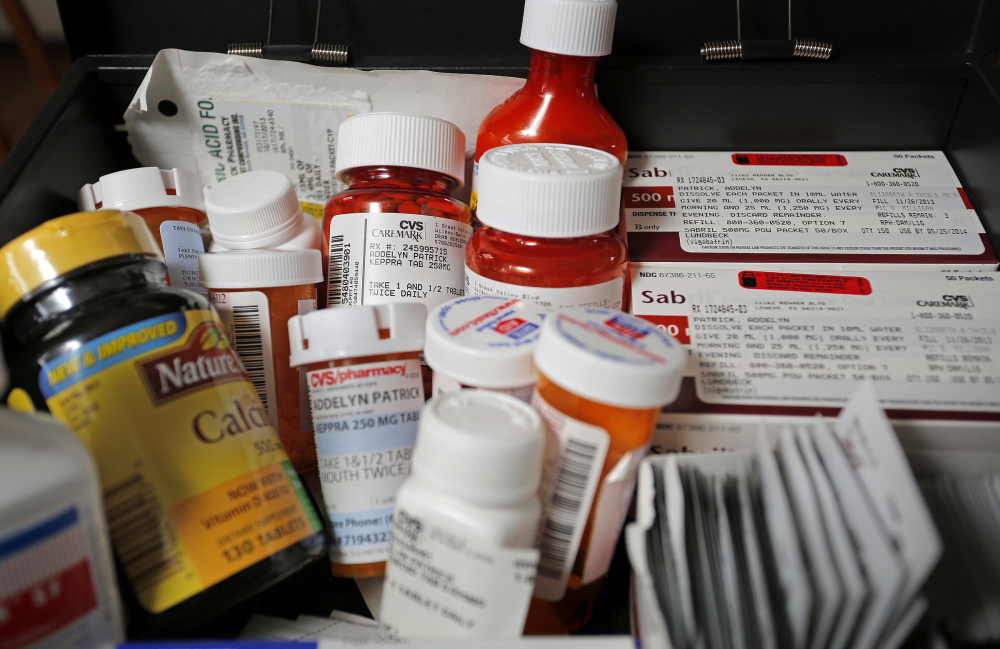On a dark night in November, Meagan Patrick drove from her home in Acton with her husband, Ken, and their two children to a medicinal marijuana dispensary in Portland. Ken parked and went in, while Meagan and the kids waited in the car. “It was literally in a back alley,” said Meagan, a 31-year-old third-grade teacher.
Just a few months ago, this errand – shopping for medicinal marijuana to treat her baby daughter’s epilepsy – would have been unfathomable.
Ken came out empty-handed. There was plenty of medicinal marijuana available but, as they had suspected, not the kind they were seeking.
So this Monday, Meagan plans to board a flight to Colorado with 13-month-old Addelyn – “Addy” – to begin the process of becoming a resident there, far from family, far from Ken’s job and their woodsy home in southwestern Maine but close to what she believes may be her best hope for her child’s future.
About 100 families nationwide have already relocated to Colorado in order to obtain a strain of medical marijuana known as “Charlotte’s Web” that has been shown to be effective in treating children with epilepsy. Originally called “Hippie’s Disappointment” by its growers because of what it lacked in traditional potency, namely the THC (tetrahydrocannabinol) that gives users a psychoactive high, this strain of high CBD (cannabidiol) marijuana was renamed for a little girl named Charlotte Figi. Researchers at the University of Reading in England found evidence that cannabidiol, one of many components in the marijuana plant, can radically reduce the number of seizures in epilepsy patients; it reacts with receptors within the body and works as an anticonvulsant. That was borne out by Charlotte Figi’s case; at age 4 she was having 300 grand mal seizures a week and had run out of pharmaceutical options. In her first week on this cannabis-derived medicine she had just one seizure. Now 6, she is 99 percent seizure-free.
In Maine, medical marijuana is legal, even for minors, provided they pass a certification process with the Department of Health and Human Services’ licensing board. But the nearly two dozen Maine families who want to try it have run into numerous roadblocks.
The first is supply. Charlotte’s Web, developed by Colorado grower Josh Stanley and his five brothers – widely referred to as the Stanley brothers – is not technically available in Maine, as the Patricks found. But Charlotte’s Web rumors fly through this network of parents, many of whom originally connected on a private Facebook group called Maine Epilepsy Parents United.
Some say there’s something just like it, or close enough, or that a Maine grower might be secretly working from a clone of the Stanleys’ plants. Others whisper that someone in California might be willing to mail another high CBD-strain to Maine. Or that maybe the high-CBD strain isn’t needed at all, that maybe the plant in its raw form could yield a medicine just as helpful. In this world where mothers ruefully count up the number of pharmaceutical options that haven’t worked on their kids and dread the possible side effects of whatever comes next, nothing seems certain but the desire to give a natural product a try.
The second major obstacle is legality. It’s not as simple as going to Colorado to pick up some clones of the Stanleys’ plants and bring them back to grow in Maine.
Under federal law, marijuana is still illegal and classified as a Schedule 1 drug without any known medical benefits and with potential for addiction and abuse; it’s in the same category as heroin and LSD. Anyone who imports it across state lines risks being charged with drug trafficking.
Even if a Maine family can obtain something similar – growers in Maine are working on high-CBD, low-THC strains right now – many of these children regularly cross state lines for doctor’s appointments at Boston Children’s Hospital or Massachusetts General. Their medicine has to go with them. As Joan Smyrski of Maine’s Division of Licensing and Regulatory Services for medicinal marijuana points out, that’s a lawbreaker.
“It’s drug trafficking,” she said.
‘DESPERATE, DESPERATE PARENTS’
What are parents supposed to do if they don’t want to break the law every time they cross the Piscataqua River Bridge?
The Patrick family is taking the most extreme approach, in part because their daughter, Addy, is at such a vulnerable age developmentally. Every seizure in effect turns off her brain, however briefly, and stops her from developing as a healthy child does. The prognosis is that she’ll likely develop more kinds of seizures as she gets older. A seizure could kill her – 34 percent of all sudden deaths in children are caused by Sudden Unexpected Death in Epilepsy, according to CURE, an epilepsy research institution – and all will steadily slow her development. But the medicines she takes are limiting her development as well, because of their side effects. She sleeps 22 out of 24 hours as is. The Patricks keep Addy’s monthly supply of anti-seizure medication in a box the size of a beauty queen’s makeup kit and it is always locked, for fear that her 4-year-old brother, Colin, might get into it.
The financial toll on her parents since her diagnosis at six months has already been considerable, even with help from family and friends, and maintaining households in two states is hardly a great option. But it represents hope, which can be hard to come by for these families.
“We are desperate, desperate parents,” said Michelle Chumsae of York. Her 8-year-old son, Miles, requires a feeding tube and full-time care. His seizures, associated with Down syndrome, began when he was 4 months old.
For several years they were under control through medication and the high-fat, low-carb ketogenic diet, but a year ago, they returned. Every new pharmaceutical she tries on Miles feels like a game of Russian roulette, Chumsae says. Will it work? And if so, will it also make him miserable? Chumsae worries that medical marijuana may be over-hyped – “We’re at risk of thinking there is some magical thing” – but if there were something entirely natural that could help these children, it would be a “game changer.”
South Berwick mother Samantha Brown’s daughter Kaylee, 2, was recently diagnosed with Dravet syndrome, a catastrophic childhood epilepsy. Her mother obtained a tincture of medicinal marijuana this fall – she declines to say where from – and has been using it with success. The seizures have slowed, and Kaylee seems happier and more active.
“I don’t know if it is a coincidence, but that week she started exploding with words,” she said.
Brown said she would consider growing plants herself, if need be. “My opinion before was just kind of neutral,” she said. “I could never have imagined growing marijuana. However, now, with the amount of healing it can do?”
A TANTALIZING PROSPECT
One in 26 of all Americans will develop epilepsy in their lifetimes, according to a spokeswoman for CURE, the epilepsy research institution, and one in 100 children will develop it. The Epilepsy Foundation estimates there are 45,000 new cases of epilepsy in children under the age of 15 each year.
Brunswick mother Christy Shake’s son, Calvin, 9, was diagnosed with epilepsy at age 2. A fierce advocate for CURE, she has chronicled her search for a better anti-seizure medicine for Calvin – who is about to try his 11th type – on her blog at www.calvinsstory.com. It’s a constant balancing act. One medicine might decrease the seizures but make him lethargic, or manic, or just give him the kind of intestinal issues that keep him chronically underweight.
She’s moving through the certification process now and believes marijuana, whether a high-CBD strain or perhaps the plant in its raw form, could help. But she needs assurance that it would be readily available.
“How do you know that you can always get this?” Shake said. Calvin spun in a bouncy chair as she spoke, making noises that she said could be laughter, gas or an indication of an approaching seizure.
The prospect of improving Calvin’s life with medical marijuana is tantalizing. “It’s at our fingertips,” Shake said.
But not quite within these parents’ grasp. Most of the Maine parents interviewed said they weren’t willing to break the law to use the drugs on their children.
Berwick mother Heather Bowie’s son Aidan, born with neurological impairments, has about 20 seizures a day and is now trying his seventh medication to treat seizures. She can’t leave the house, let alone the state, without his medications.
“The legal component is huge for me,” she said. “I am not going to cross that line, because ultimately I am no help to Aidan behind bars.”
Shake has petitioned President Obama and Maine’s congressional representatives to remove pot from the list of Schedule 1 drugs. (U.S. Rep. Chellie Pingree was one of 16 co-sponsors of HR 499, the Ending Federal Marijuana Prohibition Act of 2013, which would have declassified marijuana as a controlled substance, but the bill went nowhere this session. Pingree is married to S. Donald Sussman, majority share owner of MaineToday Media, which publishes the Portland Press Herald/Maine Sunday Telegram, Kennebec Journal and Morning Sentinel.) In 2009 the American Medical Association called for a federal review of that categorization in order to facilitate research and development of medicinal marijuana.
The Food and Drug Administration has approved trials of cannibidiol, including one on a U.K. company’s pharmaceutical version of a high-CBD medicine that the Patricks’ neurologist in Boston, Dr. Elizabeth Thiele, is working on. There is no room for Addy in that study, but her mother said Dr. Thiele gave her the go-ahead to give dispensary medicinal marijuana a try. “She told me, ‘It’s wicked safe,’ ” Patrick said.
But at the same time, she is adamant that she doesn’t want to treat her daughter with “just anyone’s backyard grow.” From their position at the forefront of the treatment, the Stanley brothers and their foundation, Realm of Caring, seem reliable to her; they test their product through both an in-house and third-party lab.
In Maine, at least one dispensary already has an in-house lab and others are adding them. The state tests medicinal marijuana regularly but only to make sure it is free of contaminants like mold or pesticides. Maine doesn’t test for potency, and Smyrski said that is unlikely to change. “I can’t imagine that this administration would think that would be the way to go,” she said.
Without a third-party lab, Maine parents who want exact science are in an “untenable situation,” said Becky DeKeuster, executive clinical director of the Wellness Connection of Maine, a network that operates half of the state’s legal medical marijuana dispensaries. She believes Maine growers will come up with the right strain for these young patients, but “we’re talking years, not months” before it is ready.
Maine Organic Therapy in Ellsworth is offering a strain called Canna-tsu, which it has tested in an in-house lab at about 6.66 percent CBD and 5 percent THC. “We would love to even drop the THC even lower,” said manager Gretchen McCarthy, “to get it down to close to 0 percent. But we are not quite there.”
And so Meagan Patrick will board a plane to Colorado on Monday, with her sick, sleepy little girl and without regrets.
“If they were growing something on Mars that might help my daughter I’d be in the backyard building a spaceship,” she said.
Mary Pols can be contacted at 791-6456 or at:
mpols@pressherald.com
Copy the Story LinkSend questions/comments to the editors.








Success. Please wait for the page to reload. If the page does not reload within 5 seconds, please refresh the page.
Enter your email and password to access comments.
Hi, to comment on stories you must . This profile is in addition to your subscription and website login.
Already have a commenting profile? .
Invalid username/password.
Please check your email to confirm and complete your registration.
Only subscribers are eligible to post comments. Please subscribe or login first for digital access. Here’s why.
Use the form below to reset your password. When you've submitted your account email, we will send an email with a reset code.